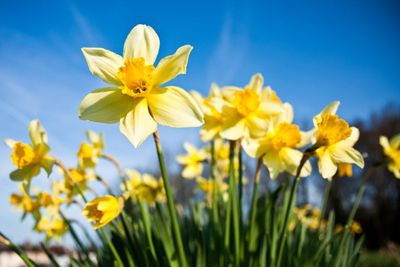Should You Water Dormant Bulbs?
Many gardeners neglect spent bulb plants or even cut off their foliage. This is a no-no, as plants need leaves to gather energy through photosynthesis. This is actually a very important part of the bulb life cycle. If plants cannot gather energy and store it in the bulb, the following season’s blooms and foliage will be negatively affected. While plants retain foliage and are doing their work, the entire plant will need to be maintained. Watering bulbs after flowering is important to support root systems and keep leaves in good condition. Think of it this way. You wouldn’t stop watering your rhododendron after it had flowered, would you? It may not need as much water to support blooms, but it still needs to have water to the root system that will keep leaves fresh and hydrated and transport nutrients to all the parts of the plant. To suspend watering would mean the plant would eventually wither and die. Dormant bulb watering is a necessary part of after bloom care and can help the plant save up energy for the next year. The xylem in plants is the vascular system that directs water into the cells and all parts of the plants. It is directly connected to the roots and water flows upward to hydrate and bring nutrients to fuel cell growth. Without water, the plant’s vascular system cannot do this important work.
About Dormant Bulb Watering
We have established that watering bulbs after flowering is a necessary chore, but how much and how frequently? This will depend on the site and the type of flowering bulb. In dry, well-draining soil, the water will redirect quickly, and plants will need to be watered more frequently, preferably when the top couple of inches (5 cm.) of soil is dry to the touch. In areas that do not drain as freely, the same touch test can be used, but the amount of water will be significantly reduced to prevent the bulb from drowning. In container grown plants, watering bulbs after flowers are gone will be a more frequent chore. This is because the container tends to dry out more quickly due to wind and ambient conditions than in ground bulbs.
General Summer Care of Spring Bulbs
As long as soil is kept moderately moist and the foliage appears healthy, some other care should be observed. Remove spent flower stems, as they force the plant to direct energy to maintaining them when you really want all the energy to go into the bulb. Do not tie up the foliage as some gardener’s urge. This reduces the leaf space that can gather solar energy to turn into stored plant sugars. Allow foliage to remain on the plant for eight weeks. Remove the foliage when it has turned yellowish brown. If the bulbs have been in the ground for several years, use a garden fork to lift them. Discard any discolored or diseased bulbs and replant clusters of two to three in separate areas. This will promote the formation of more bulbs and a healthier group of plants.
